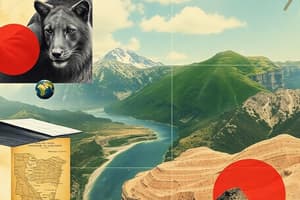Podcast
Questions and Answers
According to the Five Themes of Geography, the theme that studies how humans adapt to and modify their environment is called Region.
According to the Five Themes of Geography, the theme that studies how humans adapt to and modify their environment is called Region.
False (B)
The absolute location of a place is always described in relation to other places.
The absolute location of a place is always described in relation to other places.
False (B)
Topography is the study of the arrangement of human characteristics of an area, including architecture and traditions.
Topography is the study of the arrangement of human characteristics of an area, including architecture and traditions.
False (B)
The Five Themes of Geography are only essential for studying human geography.
The Five Themes of Geography are only essential for studying human geography.
The theme of Movement is concerned with the grouping of places that have similar characteristics.
The theme of Movement is concerned with the grouping of places that have similar characteristics.
Topographic maps are used to represent the three-dimensional landscape on a three-dimensional surface.
Topographic maps are used to represent the three-dimensional landscape on a three-dimensional surface.
Natural resources include only renewable resources such as forests and water.
Natural resources include only renewable resources such as forests and water.
Language is a system of communication used by a particular community and is not a crucial component of culture.
Language is a system of communication used by a particular community and is not a crucial component of culture.
The Earth's physical characteristics encompass only landforms and bodies of water.
The Earth's physical characteristics encompass only landforms and bodies of water.
Relief refers to the steepness or angle of the terrain.
Relief refers to the steepness or angle of the terrain.
Flashcards are hidden until you start studying
Study Notes
The Five Themes of Geography
- Location: Refers to the specific coordinates or a relative position of a place on the Earth.
- Place: Describes the physical and human characteristics that make a location unique.
- Human-Environment Interaction: Examines how humans adapt to and modify their environment.
- Movement: Concerns the mobility of people, goods, and ideas across the planet.
- Region: Involves grouping places that have similar characteristics.
Location
- Absolute Location: The exact position of a place on the Earth's surface, often given in terms of latitude and longitude.
- Relative Location: Describes a place's location in relation to other places.
Topography
- Landforms: Various features such as mountains, valleys, plains, and plateaus.
- Elevation: The height of land above sea level.
- Relief: The difference in elevation between the highest and lowest points in an area.
- Slope: The steepness or angle of the terrain.
- Topographic maps are used to represent the three-dimensional landscape on a two-dimensional surface, showing elevation changes and landform details through contour lines.
Physical Characteristics of the Earth
- Landforms: Natural features of the landscape, including mountains, hills, valleys, plateaus, and plains.
- Bodies of Water: Significant accumulations of water such as oceans, seas, rivers, lakes, and glaciers.
- Climate: The long-term patterns of temperature, humidity, wind, and precipitation in an area.
- Natural Resources: Materials provided by the Earth that humans use to produce goods and services, including renewable and non-renewable resources.
Human Geography
Unique Cultures of Regions, Countries, and Peoples of the World
- Race and Ethnic Groups: The classification of humans based on physical characteristics and cultural practices.
- Language: A crucial component of culture, language is a system of communication used by a particular community.
- Religion: Belief systems and practices that play a significant role in the culture of a region.
- Cultural Practices: Include traditions, rituals, clothing, cuisine, and social norms that define the way of life of a region.
Studying That Suits You
Use AI to generate personalized quizzes and flashcards to suit your learning preferences.




